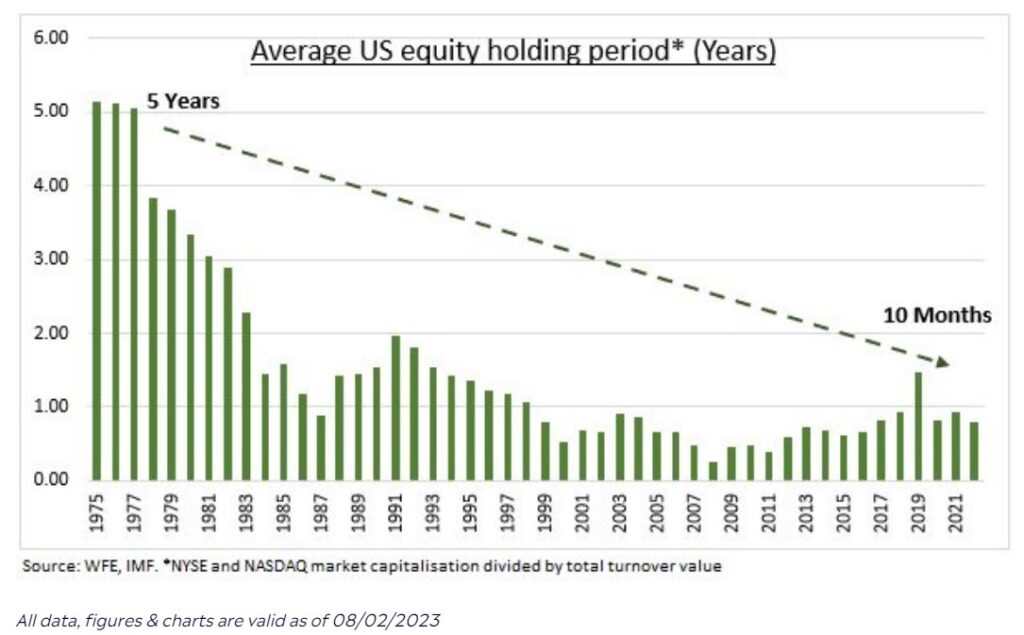
I firmly believe investing should be like watching paint dry.
Investing before the advent of the internet was cumbersome. In the 1960s and early 1970s, I remember my parents receiving share certificates which they would deposit in a safety deposit box at the bank.
In late 2020, one of my tasks as their Executor was to empty their safety deposit box. Sure enough, there were several share certificates issued decades ago. Some of these share certificates were for companies no longer in business!
The Average Holding Period Has Shrunk Over The Years
With the passage of time, the average stock holding period has been trending shorter and shorter. In the 1950s, a typical investor held shares for an average of ~8 years; a holding period refers to the time between the purchase of an asset or investment and its sale.
According to an analysis of New York Stock Exchange (NYSE) data conducted by Reuters, the average holding period for U.S. shares was 5-1/2 months in June 2020, versus 8-1/2 months at the end of 2019.
The previous record low of 6 months was hit around the period of The Great Financial Crisis.

Source: eToro
Technology Facilitates Active Trading
The ease by which investors can now buy/sell shares through online trading platforms is likely a contributing factor to the average holding period having shrunk over the years. Furthermore, brokerage fees have shrunk with some online brokerages now charging $0 commission fees for stock trades. Please don’t feel sorry for these $0 commission fee brokerage firms. They have other ways of making money!
They primarily make money through practices such as:
- selling order flow to market makers;
- earning interest on uninvested cash their clients’ accounts;
- offering premium features with additional fees, and
- charging fees on margin lending or other services like options trading;
The essentially attract clients with the “free” trading feature to generate their earnings.
Technological advances have also significantly contributed to short-term investor behavior.
Retail investors started online stock trading in the 1980s. The first online trading platform, NAICO-NET, was launched in 1982. E*TRADE, another early online trading platform, was founded in 1982 and the first online trades began in 1983.
Mobile stock trading by retail investors started around the mid-to-late 2000s. The surge in mobile trading, however, truly started in the mid-2010s.
Another step in the evolution of equity investing is the ability to trade fractional shares. The total addressable market has essentially been expanded to include people with little money. Now almost everyone can experience the thrill of active trading.
Herd Mentality And Loss Aversion
Herd mentality and loss aversion are two biases that can lead to much shorter holding periods. Many investors act on news without any understanding about the fundamentals of a company.
Heck, some people buy/sell shares without even the knowing the nature of the business in which a company engages.
Technical Analysis
Can’t read financial statements? Don’t want to learn about a company? No worries. That is what chart patterns are for.
Technical analysts use two main types of chart patterns (continuation and reversal patterns). Several continuation patterns signal that the price trend will continue and several reversal patterns signal that the price trend will change.
Many traders swear that chart patterns can provide a competitive advantage in the market. Perhaps this might be true for some investors. If these chart patterns are widely recognizable and widely used, however, how can the typical retail investor consistently outsmart everyone else who relies on the exact same information? Imagine ‘trading’ from the comfort of your home office and trying to outsmart professional investors who have much more sophisticated tools that enable them to react extremely quickly to small price movements.
Long-term investors shy away from trying to predict short-term share price behavior. Chart patterns typically are of no relevance in their decision making process.
Sucked Into The Short-Term Mindset
Not long after I retired in May 2016, I was approached to join a group of ~ 12 retail investors; almost every group member was at least 15 years older than me.
One particular group member actively employed the use of short term covered calls to generate income and encouraged other members to try his strategy. Few of us, of which I was one, decided to try his strategy.
Despite very moderate success, I found myself monitoring my investments far too often. I had essentially adopted the type of investor behavior I had vowed to avoid.
After a few months, I came to the realization that I was ill-suited for this investing approach and discontinued the use of options.
Some investors can most certainly experience success by employing various option strategies. Having to very closely monitor share price behavior, however, almost becomes a job.
When I retired, I had no intention of investing becoming my new job!
Final Thoughts
Despite the proliferation of investment solutions to facilitate the trading process thereby expanding the pool of investors, not all retail investors have a short-term mindset. The long-term investors recognize that success requires the assessment of a company’s underlying fundamentals. When such investors invest in a company the plan is to own a fractional share of a business. We have no desire to become actively involved in the business. We entrust management to navigate the company through various business conditions with the goal of maximizing long-term shareholder value.
This approach may be like watching paint dry. That is perfectly fine. We’ll seek excitement from other activities.
I wish you much success on your journey to financial freedom!
Note: Please send any feedback, corrections, or questions to [email protected].
Disclaimer: I do not know your circumstances and do not provide individualized advice or recommendations. I encourage you to make investment decisions by conducting your research and due diligence. Consult your financial advisor about your specific situation.







